
July 2006
The Daley News
I had a wonderful response to my question in the last newsletter about fruits growing outside of their normal range. It is very exciting to hear all the wonderful success stories. 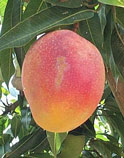 There were the huge mango's cropping heavily in Sydney, we suspect these were R2E2 due to their enormous size and vibrant colour. I loved Jim's balcony, also in Sydney, he has a fruiting pineapple and wait for it Mangos, Avocados, Olives, Monsterias, Macadamias, Rosellas, Pawpaws, Galangal, Turmeric, False Cardamon, all growing happily in pots on his balcony. David in Melbourne has a happy black sapote, longan and a mango. But the toughest of them all is Val's Tomato: "Next to the wall of the house is growing a self sown tomato which has now survived a dozen sub zero frosts and a heavy snow fall. Still green and growing in early winter in Oberon. one tough tomato!"
There were the huge mango's cropping heavily in Sydney, we suspect these were R2E2 due to their enormous size and vibrant colour. I loved Jim's balcony, also in Sydney, he has a fruiting pineapple and wait for it Mangos, Avocados, Olives, Monsterias, Macadamias, Rosellas, Pawpaws, Galangal, Turmeric, False Cardamon, all growing happily in pots on his balcony. David in Melbourne has a happy black sapote, longan and a mango. But the toughest of them all is Val's Tomato: "Next to the wall of the house is growing a self sown tomato which has now survived a dozen sub zero frosts and a heavy snow fall. Still green and growing in early winter in Oberon. one tough tomato!"
Thank you to everyone who sent me their story about growing fruit trees in difficult spaces. It proves that passion for something goes a long way toward succeeding.
Welcome To Our New Team Member
Paul Daley
 Paul is Greg's youngest and only son, born and bred at the nursery, he has done casual work with us in the team for many years but this is the first time we welcome him on board full time. Paul brings to the team not only his enthusiasm for all things green but also a passion for fruits and photography. After spending a year off working in other fields, including for a photographer in Byron Bay, Paul has returned to share his many talents with us. His enthusiasm for organic gardening, bush foods and rainforest restoration has him out in the veggie patch and planning a reforestation project for the farm in his spare time. Paul has a great eye for taking photos and many of our fruity shots are Paul's. We look forward to his inspired input on our website and here at the nursery.
Paul is Greg's youngest and only son, born and bred at the nursery, he has done casual work with us in the team for many years but this is the first time we welcome him on board full time. Paul brings to the team not only his enthusiasm for all things green but also a passion for fruits and photography. After spending a year off working in other fields, including for a photographer in Byron Bay, Paul has returned to share his many talents with us. His enthusiasm for organic gardening, bush foods and rainforest restoration has him out in the veggie patch and planning a reforestation project for the farm in his spare time. Paul has a great eye for taking photos and many of our fruity shots are Paul's. We look forward to his inspired input on our website and here at the nursery.
Fruit Tree of The Month
Carambola
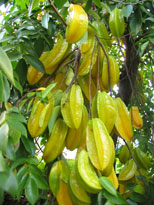 Our carambola trees here in the orchard are covered in delicious ripe fruits at the moment so it is hard not to rave about them . The trees make a beautiful specimen tree with long drooping branches that almost reach the ground, attractive foliage and very pretty small mauve flowers. The best thing about the carambola is of course the fruit. Large five or six cornered star shaped fruits adorn the trees twice a year in our region, once in Summer and again in the winter.
Our carambola trees here in the orchard are covered in delicious ripe fruits at the moment so it is hard not to rave about them . The trees make a beautiful specimen tree with long drooping branches that almost reach the ground, attractive foliage and very pretty small mauve flowers. The best thing about the carambola is of course the fruit. Large five or six cornered star shaped fruits adorn the trees twice a year in our region, once in Summer and again in the winter.
Some varieties of carambola are high in oxalic acid which in moderation is not a problem but if taken in high doses it can cause health problems. Another trait of the acidic fruits is their ability to clean and polish metals, especially brass, as it dissolves the tarnish and rust. The juice from a carambola can also be used to remove rust stains from fabric. Kary and Kembangen are sweeter less acid varieties.
Here are a couple of ideas for ways to use your fruit. Paul's juice recipe. Mix carambola, carrot, beetroot, ginger and celery, combine in a juicer, a great way to start a winters day.
For those of you with a sweet tooth how about
Carambola-honey preserve
This is easy to make. Slice the ripe fruit crosswise and place in a dish, cover with your favourite honey and leave it overnight. The following day bring the fruit and honey to the boil in a pan over a slow heat for five minutes, then fill sterilized jars, seal and store for at least one week to ensure the flavours have infused. This is a delicious preserve. For some more recipe ideas have a look at the University of Florida's web site.
Bush Foods Of the Month
There are several bush foods that fruit at this time of the year, here are some ideas as to how you may like to use them.
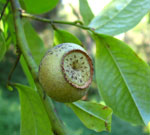 Bolwarra - Eupomatia Laurina
Bolwarra - Eupomatia Laurina
I love the bolwarra, it is an unusual and ancient understory plant that produces tasty edible fruits that are ripening now. They taste somewhat like a guava and contain many seeds and a small amount of sweet fragrant flesh. They can be used as a substitute for guava in recipes.
The Brush or Creek Lilly Pilly - Syzygium australe
I think this is one of Australia's tastiest lilly pillies as it is less astringent than other varieties. It makes a great bush snack straight off the tree. The small pink pear shaped fruits are sweet, crunchy and refreshing. It 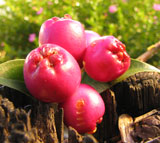 can also be made into a delicious jam. If anyone has a recipe for lilly pilly jam I'd love it if you could email me with it as we are often asked for one.
can also be made into a delicious jam. If anyone has a recipe for lilly pilly jam I'd love it if you could email me with it as we are often asked for one.
Lilly Pilly Whip - This dessert is based on a recipe from Peter Hardwick of Wilderness Foods Pty Ltd. Byron Bay
1 1/2 cups of lilly pilly fruits
2 cups of apple juice
3 level teaspoons of cornflour or arrowroot
2 level teaspoon of agar agar
Dissolve the agar-agar in 1 cup of apple juice, heat until it boils. Using 1/2 cup of apple juice, make the cornflour/arrowroot into a paste and then add the remaining 1/2 cup of apple juice. Add to agar-agar and heat to dissolve. Allow to cool slightly. Blend fruit in !/2 a cup of apple juice and combine mixtures. When it begins to set , whip, pour into serving dishes and chill. Top with whipped cream and whole lilly pillies.
Macadamia
I don't think I need to introduce the well known macadamia. For a really yummy indulgent drink.
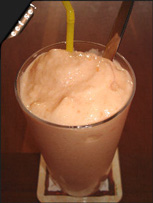 Papaya Smoothie
Papaya Smoothie
1 pawpaw
4 bananas
250g macadamias
juice of 2 tangelo's
Sugar or honey to taste
4 ice cubes
Cinnamon to sprinkle
Blend all the ingredients, except cinnamon for one minute. Pour into glasses and sprinkle with the cinnamon.





